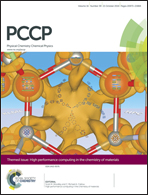The interaction of oxygen with the surface of CeO2–TiO2 mixed systems: an example of fully reversible surface-to-molecule electron transfer
Abstract
The interaction of oxygen with the surface of CeO2–TiO2 mixed oxides prepared via sol–gel was investigated by means of electron paramagnetic resonance (EPR). Upon admission of molecular oxygen onto the surface of the as prepared materials (which underwent final oxidative calcination) the formation of superoxide O2− ions is observed without the need for preliminary annealing in a vacuum and consequent oxygen depletion. The superoxide species is symmetrically adsorbed (“side-on” structure) on the top of a Ce4+ ion. Surprisingly the electron transfer is fully reversible at room temperature having the typical behavior shown by molecular oxygen carriers, which, however, link to oxygen in a completely different manner (“end-on” structure). We suggest that the active sites are Ce3+ ions present in the stoichiometric cerium titanate which forms during the synthesis. The features of these Ce3+ ions must be different from those of the same ions formed in CeO2 by reductive treatments, which show a different reactivity to O2. The observation reported here opens up innovative perspectives in the field of heterogeneous catalysis and in that of sensors as the total reversibility of the electron transfer is observed in a significant range of oxygen pressure.



 Please wait while we load your content...
Please wait while we load your content...